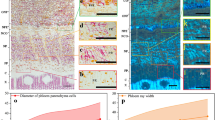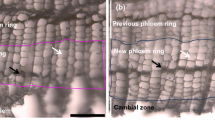Abstract
Interxylary phloem is here defined as strands or bands of phloem embedded within the secondary xylem of a stem or root of a plant that has a single vascular cambium. In this definition, interxylary phloem differs from intraxylary phloem, bicollateral bundles, pith bundles, and successive cambia. The inclusive but variously applied terms included phloem and internal phloem must be rejected. Histological aspects of interxylary phloem are reviewed and original data are presented. Topics covered include duration of interxylary phloem; relationship in abundance between sieve tubes in external phloem and interxylary phloem; distinctions between interxylary and intraxylary phloem; presence of parenchyma, fibers, and crystals in the interxylary phloem strands; development of cambia within interxylary phloem strands; three-dimensionalization and longevity of phloem, systematic distribution of interxylary phloem; physiological significance; and habital correlations. No single physiological phenomenon seems to explain all instances of interxylary phloem occurrence, but rapidity and volume of photosynthate transport seem implicated in most instances.







Similar content being viewed by others
Literature Cited
Adamson, R. S. 1934. Anomalous secondary thickening in Compositae. Annals of Botany 48: 505–514.
Bonsen, K. J. & B. J. H. ter Welle. 1984. Systematic wood anatomy of the Urticaceae. Botanisches Jarhbuch Systematik 105: 49–71.
Carlquist, S. 1958. Wood anatomy of Heliantheae (Compositae). Tropical Woods 108: 1–30.
———. 1961. Comparative plant anatomy. Holt, Rinehart & Winston, New York.
———. 1962. A theory of paedomorphosis in dicotyledonous woods. Phytomorphology 12: 30–45.
———. 1975. Wood anatomy of Onagraceae, with notes on alternative modes of photosynthate movement in dicotyledon woods. Annals of the Missouri Botanical Garden 62: 386–424.
———. 1977. Wood anatomy of Onagraceae: additional species and concepts. Annals of the Missouri Botanical Garden 64: 627–637.
———. 1981. Types of cambial activity and wood anatomy in Stylidium (Stylidiaceae). American Journal of Botany 68: 778–785.
———. 1983. Wood anatomy of Onagraceae; Further species; root anatomy; significance of vestured pits and other structures in the dicotyledons. Annals of the Missouri Botanical Garden 69: 755–769.
———. 1984. Wood anatomy of some Gentianaceae: systematic and ecological conclusions. Aliso 120: 573–582.
———. 1987. Wood anatomy of noteworthy species of Ludwigia (Onagraceae) with relation to ecology and systematics. Annals of the Missouri Botanical Garden75: 889–896.
———. 1988. Comparative wood anatomy, ed. 1. Springer Verlag, Berlin & Heidelberg.
———. 1992. Wood anatomy of selected Cucurbitaceae and its relationship to habit and systematics. Nordic Journal of Botany 12: 347–355.
———. 2001. Comparative wood antomy, ed. 2. Springer Verlag, Berlin & Heidelberg.
———. 2002. Wood and bark anatomy of Salvadoraceae: ecology, relationships, histology of interxylary phloem. Journal of the Torrey Botanical Society 129: 10–20.
———. 2007. Successive cambia revisited: ontogeny, histology, diversity, and functional significance. Journal of the Torrey Botanical Society 134: 301–332.
———. 2009. Xylem heterochrony: an unappreciated key to angiosperm origins and diversification. Botanical Journal of the Linnean Society 161: 26–65.
———. 2012. How wood evolves: a new synthesis. Botany 90: 901–140.
——— & M. A. Hanson. 1991. Wood anatomy of Convolvulaceae: a survey. Aliso 13: 51–94.
——— & S. Zona. 1988 Wood anatomy of Acanthaceae: a survey. Aliso 12: 201–227.
Chalk, L. & M. M. Chattaway. 1937. Identification of woods with included phloem. Tropical Woods 50: 1–31.
den Outer, R. W. & W. L. M. van Veenendaal. 1995. Development of included phloem in the stem of Combretum nigricans (Combretaceae). IAWA Journal 16: 151–158.
Gin, A. 1909. Réchérches sur les Lythracées, Travaux del la Laboratoire des Materiels Medicaux, Paris 6:1–166.
IAWA Committee. 1989. List of microscopic features for hardwood identification. IAWA Bulletin, new series, 10: 219–882.
Leeuwenberg, A. J. M., ed. 1980. Angiospermae: Ordnung Gentianales Fam. Loganiaceae. Die natürlichen Pflanzefamilien Band 28BI: 1–155. Ducker & Humblot, Berlin.
Leisering, B. 1899. Über die Entwicklungeschichte des interxylären Leptoms bei den Dicotyledonen. Thesis, Berlin.
Lens, F, J. Kårehed, P. Baas, S. Jansen, D. Rabaey, S. Huysmans, T. Hamann & E. Smets. 2008. The wood anatomy of the polyphyletic Icacinaceae s. l., and their relationships within asterids. Taxon 57: 525–552.
Mennega, A. 1980. Anatomy of the secondary xylem. In A. J. M. Leeuwenberg, ed. Angiospermae: Ordnung Gentianales Fam. Loganiaceae. Die natürlichen Pflanzenfamilien Band 28BI. Duncker & Humblot, Berlin.(pp. 112—161.
Metcalfe, C. R., & L. Chalk. 1983. Anatomy of the dicotyledons. Clarendon Press, Oxford.
——— & ———. 1983. Anatomy of the dicotyledons, ed. 2. Vol. 2. Wood structure and conclusion of the general introduction. Clarendon Press, Oxford.
Parthasarathy, M. V. 1980. Mature phloem of perennial monocotyledons. Berichte der deutschen botanischen Gesellschaft 93: 57–70.
Patil, V. S. & K. S. Rajput. 2008. Structure and development of inter- and intraxylary phloem in Leptadenia reticulata (Asclepiadaceae). Polish Botanical Journal 53: 5–13.
Patil, V. S., C. R. Marcati & K. S. Rajput. 2011, Development of intra- and interxylary secondary phloem in Coccinia indica (Cucurbitaceae). IAWA Journal 32: 475–491.
Pfeiffer, H. 1926. Das abnorme Dickenwachstum. Handbuch der Pflanzenanatomie 2 Abteilung 2 Teil, 9: 1–243. Gebrüder Borntraeger, Berlin.
Rajput, K. S., V. S. Patil & K. S. Rao. 2009. Development of included phloem of Calycopteris floribunda Lamk. (Combretaceae). Journal of the Torrey Botanical Society 136: 302–312.
Schenck, H. 1893. Beiträge zur Biologie und Anatomie der Lianen in Besonderen der in Brasilien einheimsche Arten. 2. Beiträge zur Anatomie der Lianen. In A. F. W. Schimper, ed. Botanische Mittheilungen der Tropens (pp. 1–271). G. Fischer, Jena.
Scott, D. H. 1891. On some points in the anatomy of Ipomoea versicolor Meissn. Annals of Botany 5: 173–180.
Scott, D. H. & G. Brebner. 1889. On the anatomy and histology of Strychnos. Annals of Botany 3: 275–302.
Singh, B. 1943. The origin and distribution of inter- and intraxylary phloem in Leptadenia. Proceedings: Plant Sciences 18: 14–19.
Solereder, H. 1908. Systematic anatomy of the dicotyledons (trans. Boodle & Fritsch). Clarendon Press, Oxford.
Sperry, J. S. 1985. Xylem embolism in the palm Rhapis excelsa. IAWA Bulletin, new series 6: 283–292.
Van Veenendaal, W. L. H., & R. W. den Outer. 1993. Development of included phloem and organization of the phloem network in the stem of Strychnos millepunctata (Loganiaceae). IAWA Journal 14: 253–265.
Van Vliet, G. J. C. M. 1979. Wood anatomy of the Combretaceae. Blumea 25: 141–223.
Weiss, J. E. 1880. Anatomie und Physiologie der fleischig verdickter Wurzeln. Flora 70: 81–119.
Acknowledgments
For providing material, thanks are due Dr. David Lorence for stems of Strychnos madagascariensis (National Tropical Botanical Garden), Dr. Peter H. Raven of the Missouri Botanic Garden for stems of various Onagraceae, and the University of California of California at Santa Barbara living greenhouse collections for material of Salvadora. John Bleck provided seeds of Orphium frutescens from which my specimens were cultivated. Mark Olson and Edward L. Schneider provided helpful suggestions. Use of laboratory facilities, including the SEM, at Santa Barbara Botanic Garden, is gratefully acknowledged.
Author information
Authors and Affiliations
Corresponding author
Rights and permissions
About this article
Cite this article
Carlquist, S. Interxylary phloem: Diversity and functions. Brittonia 65, 477–495 (2013). https://doi.org/10.1007/s12228-012-9298-1
Published:
Issue Date:
DOI: https://doi.org/10.1007/s12228-012-9298-1




